Content Libraries May Be Expensive Relics

We love all the noise about what a rich, deep and broad library streaming folks have compared to the “new kids” – Netflix, Apple.
O.K., Amazon cheated by buying theirs (MGM for $8.5B) … whoopee!
We’re just not a library kind of guy because if it’s old stuff we’ve probably seen it or don’t want to.,
The idea of watching an old show or series is boring–especially if we’ve seen it before.
Unless there’s a darn good reason!
To prepare for John Wick 4 a few months ago, we relived John Wick – 2014, John Wick Chapter 2 – 2017, John Wick Parabellum – 2019 and we were ready to see Keanu Reeves back in action.
For Matrix: Resurrection, we dug around and found Matrix – 1999, Matrix Reloaded – 2003, Matrix Revolutions – 2003 and sorry Keanu, it just wasn’t a good video game remake for us.
To prepare for Top Gun: Maverick, we had to venture back to 1976 to refresh ourselves on the antics/action of Tom Cruise and Val Kilmer.
Disney, Warner Bros. Discovery, Comcast, Amazon/MGM, ViacomCBS, Apple, and AMC Networks all tout the tremendous value of their libraries that extend back to the era when Hollywood was really Hollywood.
Their accountants are probably placing a huge value of the old content on their books and the edge they have over the techie newbies – Netflix and Apple.
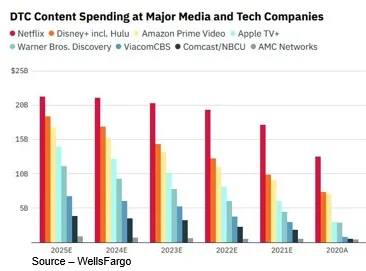
Despite that bravado, all of the studios and streamers are projected to spend a combined total of $230B this year for new stuff.
2022 Investments
According to Wells Fargo, Disney is estimated to produce 145 plus titles this year – 60 unscripted series, 30 comedy series, 25 drama series, 15 docuseries, 10 animated, five made-for-TV (streaming) movies and more.
While Zaslov is busy building his new Warner Bros. Discovery infrastructure wasting some of his $22.4B investment on sports, most of the money is earmarked for new content.
Netflix is intent on growth – especially outside the Americas – by committing $19B to its global content production.
Paramount+ (ViacomCBS) is estimated to spend $3.8B this year on content, an increase of about 25 percent year-over-year.
Originally, Wells Fargo estimated that Apple would be spending $8.1B on new content but after coming off the spectacular Oscar win for CODA this year so, instead of doubling their output this year, you will undoubtedly see them dip a little more deeply into their reserves for 2022 and beyond.
Comcast/NBCU/Peacock will invest a lot for them (increase of 22 percent) with $2.2B earmarked for new content but still well behind the other streamers. Fortunately, Comcast has a number of other sources of income to make up Peacock’s projected losses.
We realize creative folks in the Americas are already looking to pad their savings accounts with all that fresh money coming in, but only about 16 percent of the investments will be at home.
All the rest is going to the markets – 195 countries – the streamers are targeting to conquer.
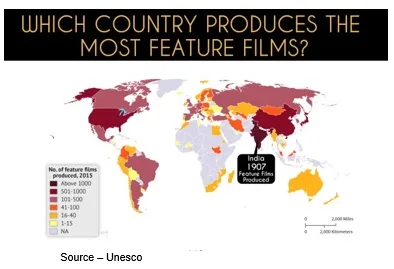
Fueled by the production spending of global and regional streaming providers, content creators everywhere will see a boost in attention because streamers have to produce at least 30 percent of their content locally.
While Netflix and Amazon are already well established in these countries, everyone else is busy increasing their local production budget – Africa, Middle East- 46 percent, Latin America – 33 percent, Oceania – 33 percent.
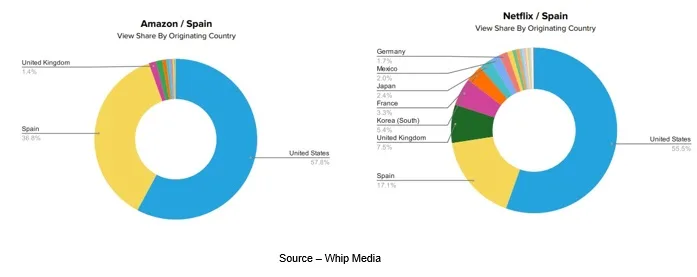
The two have found that creating content locally is also good globally because production costs are lower and, more importantly, the content travels well from one country to another … including the Americas.
In addition, the streaming industry investment will probably be twice that amount when you also factor in things like co-financing and acquiring rights to indie films/TV programming.
Video story production is accelerating even as the Hollywood/network establishment brags about their vaults full of ready-to-show stuff.

But will people watch it?
Back in the day, we LMAOed watching Airplane and Blazing Saddles … great storylines, great scripts back then.
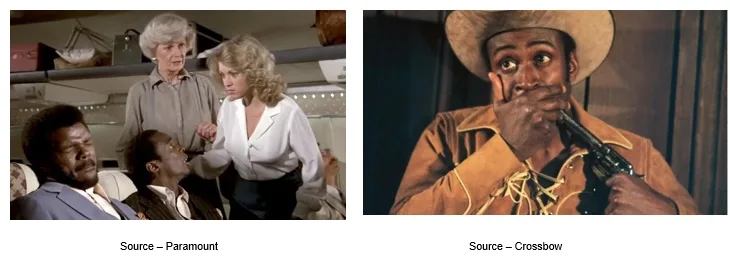
Consider just a bit of the Airplane script:
First Jive Dude – “Shiiit, man. That honky mofo messin’ mah old lady – got to be runnin’ cold upside down his head, you know?”
Jive Lady – “Jive-ass dude don’t got no brains anyhow! Shiiiiit.”
On the film’s 40th anniversary, the producer was asked if he could make Airplane today and he responded, “Of course, we could. Just without the jokes.”
Blazing Saddles had a great Mel Brooks script:
Bart – “Hey, where are the white women at?”
Lili Von Shtupp – “Tell me, schatze, is it true what they say about the way you people are … gifted?”
Governor Lepetomane – “Are you crazy? They’ll never go for it. And then again, they might. Those little red devils … they love toys!”
Times change, people’s tastes/priorities change and there’s a greater attention (and hopefully understanding) of the need for diversity, inclusion and equity in the video projects that are produced and made available.
Then too, there are the films we’re just embarrassed to watch because honestly, it’s hard to believe that it wasn’t that long ago, we didn’t treat people as people.
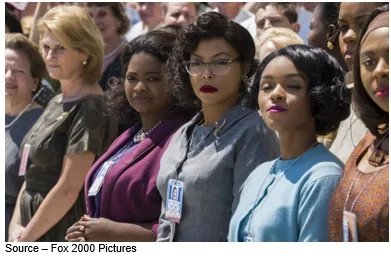
We couldn’t figure out why Taraji Henson had to walk across the NASA facility in the rain to go to the bathroom as we watched Hidden Figures.
There had to be a bathroom closer, and we were disgusted, ashamed.
When Kevin Costner smashed the bathroom sign and said, “We all pee the same color,” we nearly cheered out loud (we were on a plane), but we did whisper ‘way to go’ under our breath.
When John Glenn (Glen Powell) said, “if she says they’re good, I’m ready to go,” we thought you’re pretty smart for a guy who’s going to ride a rocket to the moon.
Don’t get us wrong, we don’t mind being embarrassed about our past and learning that backward people were in their thinking/actions just a few years ago because it makes us realize how much further we have to go.
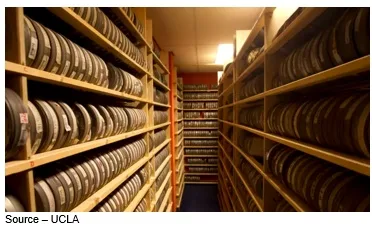
But has anyone ever looked, really looked, at those vast libraries of really great, attractive content people are just itching to see again or for the first time?
Amazon’s MGM library has more than 4,000 films and 17,000 TV shows that go back to the mid-1920s.
Warner Bros Discovery has a film library that extends back before Gone With the Wind and lots of projects that they wouldn’t want to put on HBO Max without a warning label.
And when do you think Paramount + will schedule All in the Family for streaming?
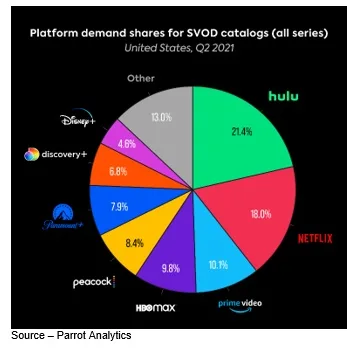
Yes, all of the streamers have libraries of expensive content they’d probably like to use to beef up their streaming content inventories; but times change, attitudes change, priorities change.
Consider the globally recognized and loved Disney.
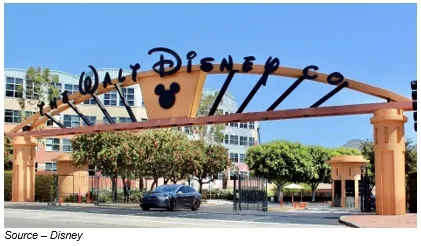
Every month, Chapek and his team gather for a video conference with advisors to evaluate/discuss films in the can as well as new projects to do what Walt Disney first envisioned the company to do when the conglomerate was founded in 1923…be the family-friendly folks that made movies, TV shows, park rides for everyone.
The monthly cross-section meetings are designed to pick out stereotypes, insensitive imagery and provide perspective.
Some shows/films are added to Disney + as is, while others are considered to be ready for the streaming roster with some editing/rework.
Still others have a disclaimer added “negative depictions and/or mistreatment of people or cultures.” And an unknown number of projects are moved back to the darkest portion of the content vault to fade into oblivion.
Chapek’s predecessor, Bob Iger, pushed the entertainment company to emphasize diverse casting/storytelling and to have greater inclusion and equality.
Iger’s goal was to encourage people to accept multiple views of cultures, race, differences.
And it worked pretty well…
Black Panther had a largely Black cast, was a powerful Afrocentric story line and was a global blockbuster.
Star Wars was refocused around female characters and animated movies like Moana, Coco, Raya and the Last Dragon, Soul, Encanto showcased a variety of races, cultures, ethnicities and were widely enjoyed by their audiences.
But…
The real world seems to be suddenly ugly with every partisan side/view insisting Chapek isn’t doing right by his people.
In trying to offend no one, Chapek and Disney are suddenly affecting everyone.
In March, Chapek told employees, “Our diverse stories are our corporate statements. I firmly believe that our ability to tell such stories is the best solution.”
He’s probably right because what is trending on Twitter, Facebook, TikTok, Instagram, Snapchat, Pinterest and the range of other social media sites is often replaced tomorrow by a new complaint.
 But still, there’s a lot of content sitting in studio/streamers libraries that were wrong then and they’re certainly wrong today.
But still, there’s a lot of content sitting in studio/streamers libraries that were wrong then and they’re certainly wrong today.
The key is being aware of the missteps of the past and preventing them again in the future.
Streaming services have to focus on today and tomorrow. Otherwise, it’s like Jacob said in The Librarians, “It doesn’t feel like you’re trying to build a team. It feels like you’re trying to fill a void.”
New, unique content may be a better solution for building a service’s future.
We’re pretty sure content creation and production folks will agree.
# # #
Andy Marken – [email protected] – is an author of more than 700 articles on management, marketing, communications, industry trends in media & entertainment, consumer electronics, software, and applications. An internationally recognized marketing/communications consultant with a broad range of technical and industry expertise especially in storage, storage management and film/video production fields; he has an extended range of relationships with business, industry trade press, online media, and industry analysts/consultants.